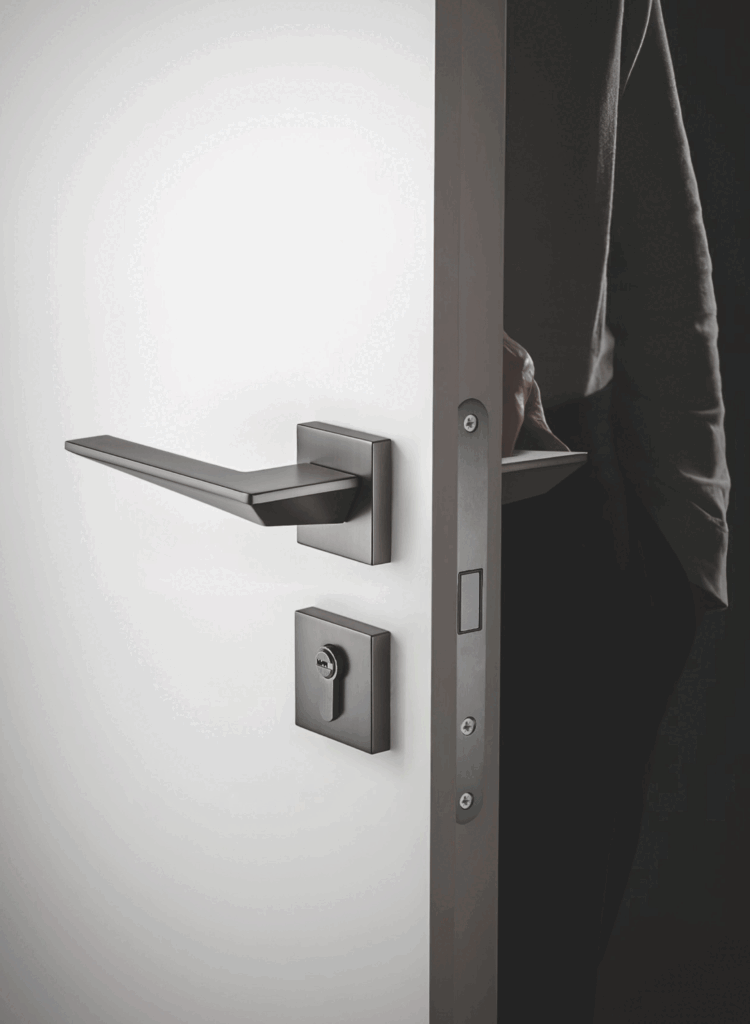Powder coating is a preferred finishing method for door hardware, offering durability, environmental benefits, and a wide selection of colors. However, a frequent issue encountered during this process is the appearance of pinholes—tiny holes or craters on the coated surface. These defects not only reduce visual appeal but also affect the protective qualities of the coating. Understanding the causes of pinholes and their prevention is crucial for achieving high-quality results.
What Are Pinholes?
Pinholes are small, visible imperfections on the surface of powder-coated mechanical locks, door handles, hinges, peepholes, and door closers. They result from trapped gases, contaminants, or incorrect application techniques. Pinholes differ from air bubbles, originating from gas released by certain substrate materials rather than the coating process.

Common Causes of Pinholes
- Surface Contamination
Dirt, oil, grease, or moisture present on the metal surface before coating can lead to pinholes. These contaminants trap air or gas, which escapes during curing, leaving behind holes. Even minor contamination can impact adhesion and finish quality. Learn about proper surface preparation. - Improper Surface Preparation
Inadequate cleaning, degreasing, or sandblasting can leave residues that prevent proper adhesion and contribute to pinholes. Metals with residual oxides or untreated surfaces may not bond effectively with the powder coating, leading to defects. Explore effective pre-treatment methods. - Excessive Coating Thickness
Applying an overly thick layer of powder coating can cause trapped air or gas to escape unevenly, leading to pinholes. A controlled and even application ensures optimal adhesion and finish quality. If thickness varies significantly across the surface, the thicker areas may develop pinholes due to incomplete gas escape during curing. - Trapped Air or Moisture in the Substrate
Certain materials inherently retain more air or moisture, which expands when heated during curing, creating pinholes. This is especially common in:- Cast iron and cast steel: These materials tend to have small air pockets formed during the casting process.
- Magnesium-aluminum alloys and zinc alloys: Due to their porous nature, they can release gases when heated.
- Hot-rolled steel: If not properly pre-treated, mill scale and residual moisture can contribute to pinhole formation.
- Uncured or Excessively Thick Conductive Putty
When conductive putty is applied too thickly or has not fully dried before powder coating, it can trap air, leading to pinholes during the curing process. - Incorrect Spray Application
- If the spray gun is positioned too close to the workpiece, excessive static charge may cause an uneven coating and lead to defects.
- High voltage settings can also cause the coating to be applied too aggressively, leading to pinholes and other issues.
- Volatile Gas in the Curing Oven
If the curing oven contains excess volatile gases, it can interfere with the powder coating process, creating pinholes. - Low-Quality Powder Coating Material
Substandard or improperly stored powder coatings may contain impurities, inconsistent particle sizes, or volatile compounds that lead to pinholes. Using high-quality powder formulations from reputable suppliers ensures better adhesion and minimizes defects. Discover premium powder coating options.
How to Prevent Pinholes
- Strengthen Workpiece Processing: Ensure the workpiece surface is properly machined to minimize surface air pockets.
- Improve Pre-Treatment Processes: Thoroughly clean and degrease parts before coating. Remove rust and oxidation completely.
- Extend Baking Time: Allow sufficient curing time for the powder coating to properly bond to the surface and release trapped gases.
- Adjust Process Parameters: Optimize spray gun distance, voltage settings, and application techniques to prevent coating defects.
- Clean the Curing Oven: Regularly remove volatile gases and contaminants from the curing chamber to prevent interactions with the coating.
- Control Coating Thickness: Maintain an optimal coating thickness between 50–80μm to reduce defects and improve adhesion.
- Use High-Quality Powder Coatings: Invest in reliable powders that are formulated to minimize pinholes and other imperfections.
Additional Considerations for Different Substrates
Since some materials are more prone to pinholes than others, additional strategies may be required:
- For cast metals: Pre-bake components to release trapped gases before applying powder coating.
- For aluminum and zinc alloys: Use specialized powder coatings designed for these materials to minimize outgassing.
- For cold-rolled steel: Ensure proper degreasing and remove any mill scale before coating.
Why Choose SUZHOU UMAY?
At SUZHOU UMAY, we specialize in high-quality door hardware with precision-applied powder coatings, ensuring flawless finishes free from pinholes and other defects. With extensive industry expertise, we provide tailored solutions for manufacturers and businesses seeking premium, defect-free coatings. Our products include mechanical locks, door handles, hinges, peepholes, and door closers, all designed for superior performance and durability. Contact us to learn more.
Share This Story, Choose Your Platform!

